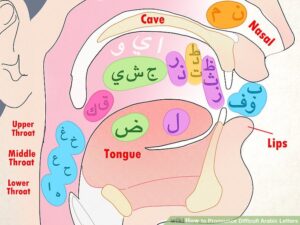Mastering Arabic pronunciation can be challenging for non-native speakers due to the unique sounds that don’t exist in many other languages. However, with practice and the right approach, it can be significantly improved.
Common Pronunciation Challenges
- Distinct Arabic Sounds:

- Arabic has some sounds that are not found in many other languages. These include:
- ع (‘Ayn): A voiced pharyngeal fricative, produced by constricting the throat.
- غ (Ghayn): Similar to the French “r” or the German “ch” in “Bach,” pronounced at the back of the throat.
- ق (Qaf): A deep “k” sound, produced at the back of the mouth.
- ح (Haa’): A voiceless pharyngeal fricative, produced by constricting the throat without voicing.
- Arabic has some sounds that are not found in many other languages. These include:
- Short and Long Vowels:
- Arabic distinguishes between short and long vowels. Non-native speakers often struggle with maintaining the correct vowel length. For example:
- بَتَّ (batta) means “he cut.”
- بَتَ (bata) means “he started.”
- Arabic distinguishes between short and long vowels. Non-native speakers often struggle with maintaining the correct vowel length. For example:
- Emphatic Consonants:
- Arabic has emphatic (pharyngealized) consonants like ص (Saad), ض (Daad), ط (Taa’), and ظ (Zaa’). These are pronounced with a constricted throat, which adds a “thick” quality to the sound.
- Clustered Consonants:
- Arabic often combines consonants without intervening vowels, which can be difficult for speakers of languages that do not have such clusters, e.g., بِقْسْمٍ (biqsm, “by a department”).
- Stress Patterns:
- Arabic has different stress patterns that can change the meaning of words. Stress usually falls on the penultimate (second to last) syllable in most cases but can shift depending on word structure.
Tips for Improving Pronunciation
- Listen and Imitate:
- Immersing yourself in Arabic by listening to native speakers through podcasts, news, or conversation can help. Try to imitate the intonation, rhythm, and sounds as closely as possible.
- Focus on Difficult Sounds:
- Identify which sounds you find most difficult and spend extra time practicing them. For instance, if the “ع” sound is challenging, practice by saying words like عَرَبِي (Arabi) repeatedly.
- Use Visual and Audio Aids:
- Utilize online resources that provide both visual (mouth position) and audio (pronunciation) examples. Seeing how native speakers shape their mouths when pronouncing certain sounds can be incredibly helpful.
- Slow Down:
- Don’t rush through words. Speak slowly, paying close attention to each sound. This helps in mastering the correct pronunciation and intonation.
- Practice with Native Speakers:
- Engage in conversations with native Arabic speakers. They can provide real-time feedback on your pronunciation and help you correct mistakes immediately.
- Record Yourself:
- Record your speech and compare it to native speakers. This will help you notice subtle differences and adjust accordingly.
Practicing Difficult Sounds
- Start with Isolated Sounds:
- Begin by practicing difficult sounds in isolation. For example, work on غ by repeating words like غُرْفَة (ghurfa, “room”).
- Move to Simple Words:
- Once comfortable with isolated sounds, practice them within simple words. For instance, practice the sound ق in words like قَلْب (qalb, “heart”).
- Practice in Context:
- Use the sounds in sentences or phrases to get accustomed to their use in natural speech. This helps in mastering not just the pronunciation but also the rhythm and flow of the language.
- Mouth and Throat Exercises:
- Certain Arabic sounds require specific mouth and throat positions. Practice exercises that strengthen your control over these muscles, like repeatedly saying ع and ح sounds.
Resources for Pronunciation Practice
- Arabic Pronunciation Guides:
- Websites like Forvo provide user-generated pronunciations for various Arabic words, helping you hear how words are pronounced in different dialects.
- Language Learning Apps:
- Apps like Rosetta Stone and Duolingo include pronunciation practice, offering instant feedback on your pronunciation.
- YouTube Channels:
- Channels like eArabicLearning offer pronunciation lessons, breaking down difficult sounds and words in Arabic.
- Online Tutors:
- Platforms like eArabicLearning offer one-on-one tutoring sessions with native Arabic speakers who can help with pronunciation.
- Arabic Dictionaries with Audio:
- Use dictionaries like Al-Maany or Reverso, which often include audio pronunciations for words.
- Pronunciation Apps:
- Elsa Speak and Pimsleur offer focused pronunciation practice and drills tailored to your specific pronunciation challenges.
By consistently applying these tips and utilizing the available resources, non-native speakers can significantly improve their Arabic pronunciation, making their speech more accurate and understandable.
